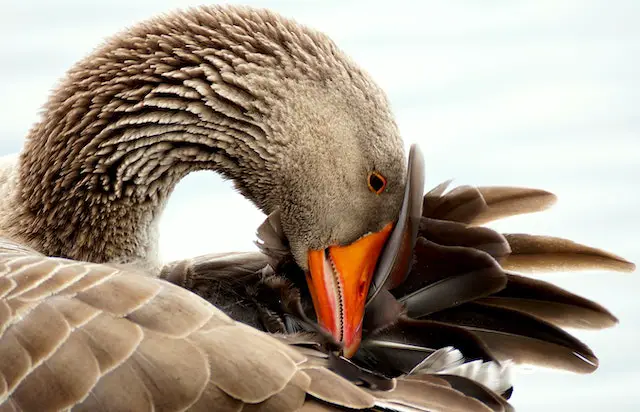Birds have developed fascinating and unique ways of caring for their feathers, a crucial aspect of their health and survival.
One such behavior is preening, which involves the cleaning and maintenance of feathers.
In this article, we will explore the different types and techniques used in preening, as well as its importance for birds.
Table of Contents
- 0.1 Definition of Preening
- 0.2 Importance of Preening for Birds
- 0.3 Overview of Different Types of Preening
- 1 Types of Preening
- 2 Techniques Used in Preening
- 3 Preening Behaviors in Different Bird Species
- 4 Conclusion
- 5 FAQs: Preening: The Art of Feather Maintenance in Birds!
- 5.1 What is preening in birds?
- 5.2 Why is preening important for birds?
- 5.3 What are the different types of preening?
- 5.4 How do birds clean their feathers?
- 5.5 What is the role of the oil gland in preening?
- 5.6 Do all bird species preen in the same way?
- 5.7 How does preening contribute to social bonds among birds?
- 5.8 What are the benefits of wing stretching during preening?
- 5.9 Can birds digest bones during preening?
- 5.10 How does preening contribute to bird health and survival?
- 6 Author
Definition of Preening
Preening is the act of maintaining feathers through grooming behaviors such as cleaning, aligning, and removing dirt or debris.
It is an instinctual behavior that has evolved over millions of years to keep birds healthy and functioning properly.
Preening is essential for the health of a bird’s feathers since they provide insulation against cold weather, enable flight, and protect against water damage.

Importance of Preening for Birds
Preening plays a vital role in the survival of birds by ensuring that their feathers remain healthy and functional.
Without proper feather maintenance, birds would be unable to fly efficiently or effectively regulate their body temperature.
Additionally, damaged or dirty feathers can lead to infections or other health problems.
Preening also helps maintain social bonds within bird communities by providing opportunities for individuals to groom one another.
For example, some birds engage in mutual preening where one bird cleans the other’s hard-to-reach areas such as the head or neck.
Overview of Different Types of Preening
There are two main types of preening: feather maintenance and oil gland maintenance.
Feather maintenance involves cleaning individual feather barbs with the bill or rubbing them together to remove dirt or debris.
This type also includes aligning disheveled feathers using oil produced by a gland near the base of a bird’s tail.
Oil gland maintenance involves spreading oil on feathers using specialized feathers called “uropygial” or “preen” feathers.
These feathers produce a waxy substance that birds spread across their feathers to repel water, maintain feather flexibility and strength, and protect against harmful bacteria.
In the following sections, we will explore each type of preening in more detail. We will also examine the various techniques used by different bird species to preen themselves and others.
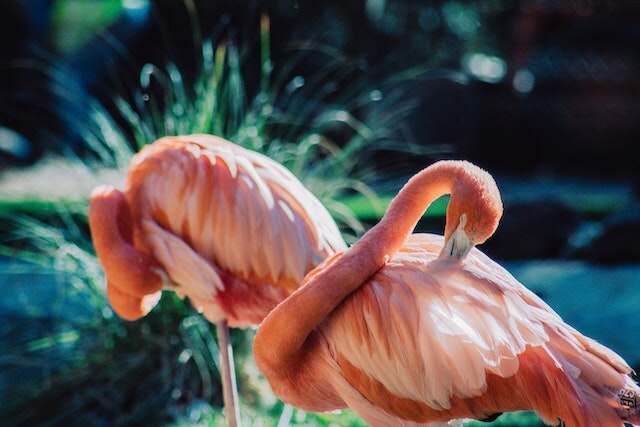
Types of Preening
Feather Maintenance
One of the primary purposes of preening in birds is to maintain their feathers. Feather maintenance involves a range of activities, including cleaning, aligning, and removing dirt and debris from feathers.
A bird’s feathers are essential for flight, insulation, and displaying vibrant colors during mating season.
Therefore they must be kept in good condition. Cleaning feathers is a crucial aspect of feather maintenance.
Birds use their beaks to clean the feathers by nibbling at them or rubbing them against each other. They may also use their feet or wings to reach difficult spots.
During this process, birds remove excess oil and dirt buildup that can accumulate on the surface of the feathers. Feathers tend to get out of alignment as a result of wear and tear over time.
Birds align their feathers by running individual filaments through their bill’s beak from base to tip and straightening them out, so they lie flat on top of one another.
This process improves aerodynamics when flying.
Removing dirt and debris from feathers is another critical component in feather maintenance.
Dirt and debris can interfere with feather function by preventing proper insulation or interfering with structural integrity during flight operations.
Oil Gland Maintenance
Birds have an oil gland located near the base of their tail called the preen gland that produces an oily substance called sebum. The gland secretes a lipid-rich material that helps waterproof birds’ feathers when spread across them during preening.
One significant function of the oil gland in birds is waterproofing its plumage against water damage – while swimming or diving underwater – as well as preventing excessive heat loss or gain due to exposure to wetness or rain.
Spreading oil over its entire body through preening ensures all areas receive coverage—birds often take advantage of opportunities like sun-bathing after a swim; this allows for the oil to dry and distribute evenly over their feathers.
The oil also contains vitamin D, which is essential for bird skin and bone health. Feather maintenance and oil gland maintenance are both necessary types of preening in birds.
On the other hand, oil gland maintenance helps waterproof their plumage against water damage and regulate body heat when exposed to wetness or rain.
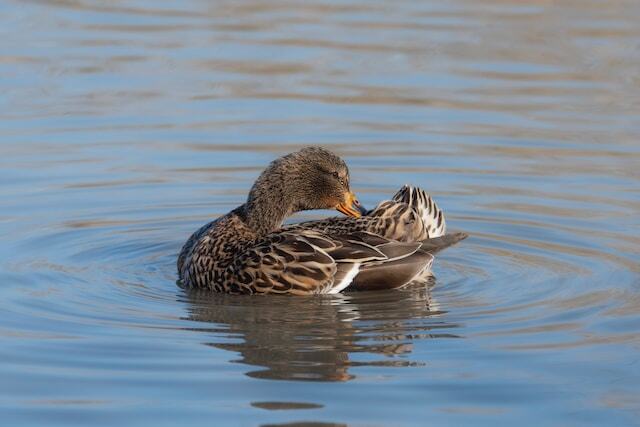
Techniques Used in Preening
Birds have developed various techniques to help them maintain their feathers and keep them healthy.
Preening is an essential part of a bird’s daily routine, and they use different methods to clean their feathers, oil their wings, and keep themselves in top condition.
In this section, we’ll explore some of the most common preening techniques used by birds.
Bill Wiping
One of the most common preening techniques that birds use is bill wiping. Birds use their bills to clean their feathers and remove dirt and debris from their faces.
They also use their bills to apply oil from the oil gland to their feathers for waterproofing.
The technique involves using the mouth and bill to wipe along the length of each feather or body part that needs cleaning.
During bill wiping, a bird may also use its saliva to moisten its feathers slightly or remove dirt that has built up on its bill.
The technique can take several minutes or more, depending on how dirty or tangled the bird’s feathers are.
Cleaning the Bill and Face with Bill Wiping Technique
Many birds spend a lot of time grooming themselves with bill wiping, since it helps them remove parasites such as mites and lice that can cause skin irritation or infections.
A bird will typically start by wiping its beak on a solid surface like a branch or rock before proceeding to clean other parts of its body.
Depending on the species of birds, some may have more elaborate facial feather arrangements that require extra attention when cleaning.
For instance, some species have sensitive nostrils located at the base of their bills that need regular cleaning with specialized techniques.
Wing Stretching
Another important technique used in preening is wing stretching. Birds stretch out one wing at a time while standing on one leg; they extend each wing fully, then fold it back in.
This technique helps them maintain the flexibility and strength of their feathers, which is essential for flying.
Stretching Wings to Maintain Feather Flexibility and Strength
Wing stretching also helps birds with maintaining their balance, since it enables them to use one leg at a time while standing on branches or other surfaces.
Birds typically stretch their wings several times a day, both after waking up in the morning and before settling down to sleep at night. Preening is an essential behavior that birds undertake regularly.
Through bill wiping and wing stretching techniques, birds keep their feathers healthy and clean, which is crucial for their survival.
Understanding these techniques can help bird watchers better appreciate the fascinating world of birds and their behaviors.
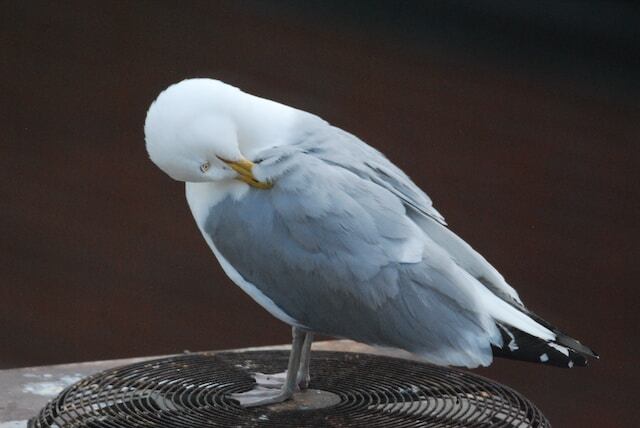
Preening Behaviors in Different Bird Species
Birds are an incredibly diverse group of animals, with over 10,000 different species found across the world.
And while all birds engage in preening behaviors to some extent, the specific techniques and methods used can vary widely between species.
In this section, we’ll take a closer look at how three different bird species – penguins, parrots, and owls – approach preening.
Penguins: Preening in Aquatic Birds
Penguins are unique among birds in that they are adapted for life in aquatic environments. This means that their preening behaviors have evolved to accommodate their specialized lifestyle.
Unlike most other birds, penguins cannot use their beaks to spread oil on their feathers for waterproofing.
Instead, they rely on a unique gland located near the tail that produces a waxy substance similar to petroleum jelly. Penguins use their beak to rub this substance onto their feathers during preening.
Additionally, because penguins spend much of their lives swimming and diving underwater, they often take longer pauses during grooming sessions than other birds do.
This is because they need to surface periodically for air.
Parrots: Feather Maintenance with Beaks
Parrots are well-known for their intelligence and social nature – but did you know they’re also expert preeners? Parrots use their beaks not just for cracking nuts and eating fruits and seeds; they also employ them extensively during feather maintenance.
One reason parrots are such good feather groomers is that many of them have zygodactyl feet- two toes pointing forward and two pointing backward-which allows them greater dexterity when picking at hard-to-reach feathers.
In addition to using their beak to clean individual feathers thoroughly, some parrot species will even use their tongues as a grooming tool!
Owls: Using Talons to Groom Feathers
Owls are nocturnal hunters with incredibly sharp talons, which they use not just for capturing prey, but also for grooming.
Unlike most other birds, owls cannot move their eyes in their sockets; instead, they rotate their heads nearly 270 degrees to scan their surroundings.
This means that maintaining good vision is critical to their survival – and clean feathers are essential for unobstructed sight.
When preening themselves, owls will use their sharp talons to pick at individual feathers and remove any dirt or debris that has accumulated there.
They may also use their beak in conjunction with their feet, depending on the location of the targeted feather.
Despite being predators, owls are surprisingly delicate during preening – they need all the sensitive whiskers around their face intact for hunting.
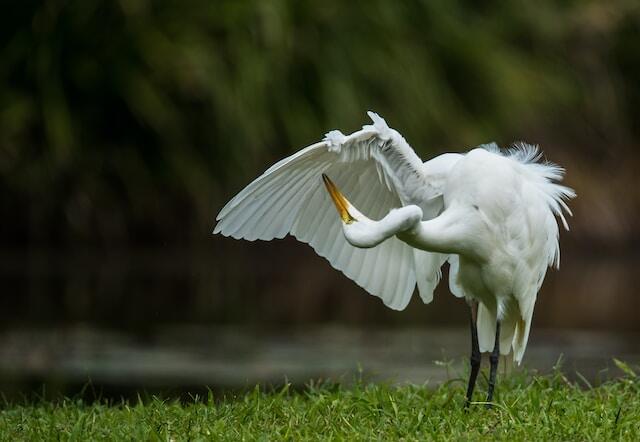
Conclusion
Importance of Preening for Bird Health and Survival
Preening is an essential behavior for birds’ health and survival. It helps them maintain their feathers to keep them in good condition, protecting them from harsh weather conditions, and ensuring they remain warm.
Proper feather maintenance also allows birds to fly efficiently, escape predators quickly, attract mates during breeding season, and even avoid disease.
Preening also helps distribute natural oils from the uropygial gland throughout the feathers to provide waterproofing.
Birds that don’t preen regularly might have poorly-maintained feathers that can lead to a host of problems such as infections, parasites infestation, feather damage that can lead to difficulties flying or thermoregulating effectively.
This can result in difficulty obtaining food or evading predators – ultimately leading to death.
Summary
Preening is a critical behavior necessary for bird maintenance and survival. Different types of preening consist of cleaning feathers by aligning them properly and removing dirt debris; maintaining oil glands by spreading oil on feathers for waterproofing.
Birds use different techniques such as bill wiping and wing stretching while engaging in various preening behaviors depending on their species.
Each bird’s unique method of preening is essential for its survival in the wild, as it ensures optimal feather condition that regulates body temperature while allowing efficient flight movement required for migration & hunting prey.
By practicing proper preening behaviors regularly, birds require less energy expenditure during flight & mating rituals needed in extreme weather conditions.
Overall, understanding how birds maintain themselves through regular grooming practices like preening highlights the importance of preserving their habitats, so these precious creatures can continue thriving without human intervention or endangerment further into the future.
As members of our ecosystem’s diverse community—birds need our support now more than ever as climate change continues threatening their natural habitats worldwide – let’s protect our feathered friends by doing everything we can to preserve their environments.
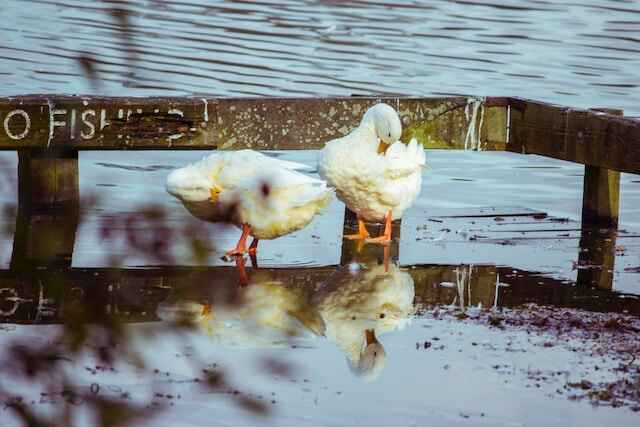
FAQs: Preening: The Art of Feather Maintenance in Birds!
What is preening in birds?
Preening is the instinctual behavior in birds involving the cleaning, aligning, and maintenance of their feathers. It helps keep their plumage healthy, functional, and essential for activities like flight, insulation, and attracting mates.
Why is preening important for birds?
Preening plays a vital role in a bird’s survival by ensuring their feathers remain healthy and functional. It helps birds fly efficiently, regulate body temperature, and protects against infections or health issues caused by damaged or dirty feathers.
What are the different types of preening?
There are two main types of preening: feather maintenance and oil gland maintenance. Feather maintenance involves cleaning and aligning feathers, while oil gland maintenance involves spreading oil from a gland for waterproofing and protection against bacteria.
How do birds clean their feathers?
Birds clean their feathers by using their beaks to nibble, rub, or run individual filaments through their bill to remove dirt, debris, and excess oil. They may also use their feet or wings to reach difficult spots and keep their feathers clean and in good condition.
What is the role of the oil gland in preening?
Birds have an oil gland near the base of their tail, known as the preen gland, which produces an oily substance called sebum. This oil is spread on feathers during preening, providing waterproofing, maintaining feather flexibility and strength, and containing essential nutrients like vitamin D.
Do all bird species preen in the same way?
While all bird species engage in preening to some extent, specific techniques and methods can vary widely. Different species have adapted preening behaviors to suit their unique lifestyles, such as penguins using a waxy substance from a gland, parrots using their beaks extensively, and owls using their talons for grooming.
Preening also helps maintain social bonds within bird communities. Some birds engage in mutual preening, where they clean hard-to-reach areas of other individuals, strengthening social relationships and promoting bonding among group members.
What are the benefits of wing stretching during preening?
Wing stretching is an important preening technique that helps birds maintain feather flexibility and strength, improving their flight capabilities. It also aids in balance and allows birds to use one leg at a time while standing on branches or other surfaces.
Can birds digest bones during preening?
Birds, such as eagles, have powerful jaw muscles and specialized adaptations to break down bones as part of their diet. While hawks may consume smaller bones, they generally do not have the same capability as eagles in extensively digesting bones.
How does preening contribute to bird health and survival?
Preening is crucial for bird health and survival. It ensures feathers remain in good condition for insulation, flight, and vibrant displays. Proper preening helps birds regulate body temperature, fly efficiently, avoid infections, and maintain overall well-being in their natural habitats.

